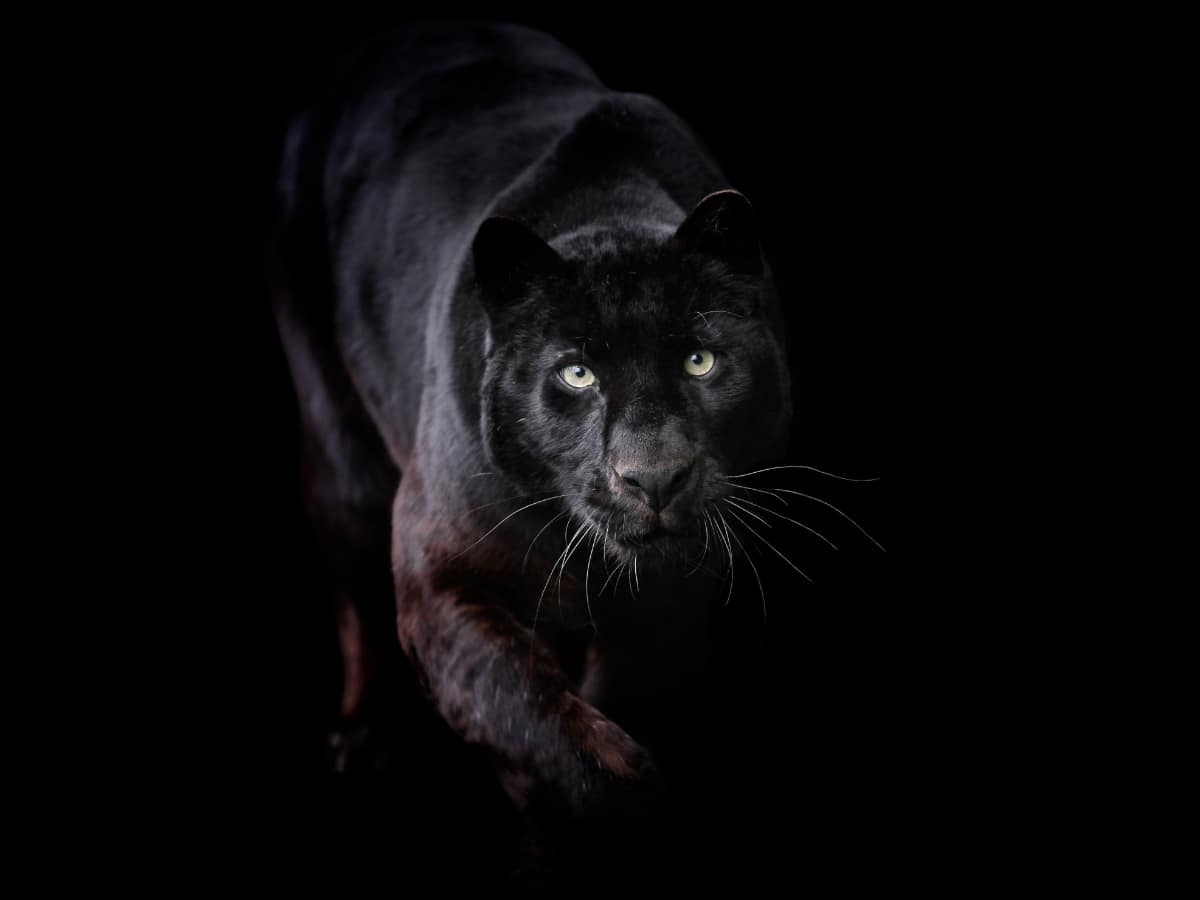Black animals are pretty rare in nature. However, their deep coloration adds elegance and mystery to the animal kingdom.
The black color in animals can result from various factors, including genetic mutations (a condition called melanism), genetic variations, environmental adaptations, or evolutionary traits.
In today’s article, we’ll explore some of the most beautiful black animals found in nature, from majestic panthers to tiny bats. Join us on this journey into the shadows of the wild.
Black versus Melanistic Animals
Black animals and melanistic animals share one thing in common: coloration. The former refers to animals whose coloration stems from various factors like genetics, adaptation, or natural variation.
In contrast, melanistic animals are characterized by a genetic condition that produces excessive melanin, resulting in a remarkably dark or black appearance.
Melanism can occur due to genetic mutations that cause an increased production of melanin, making the animal appear much darker than its normal counterparts.
However, not all black animals are necessarily melanistic, as some may have black coloration due to other factors such as camouflage or environmental adaptation.
List of Black Animals
Here are some of nature’s most stunning black animals:
1. Black squirrel
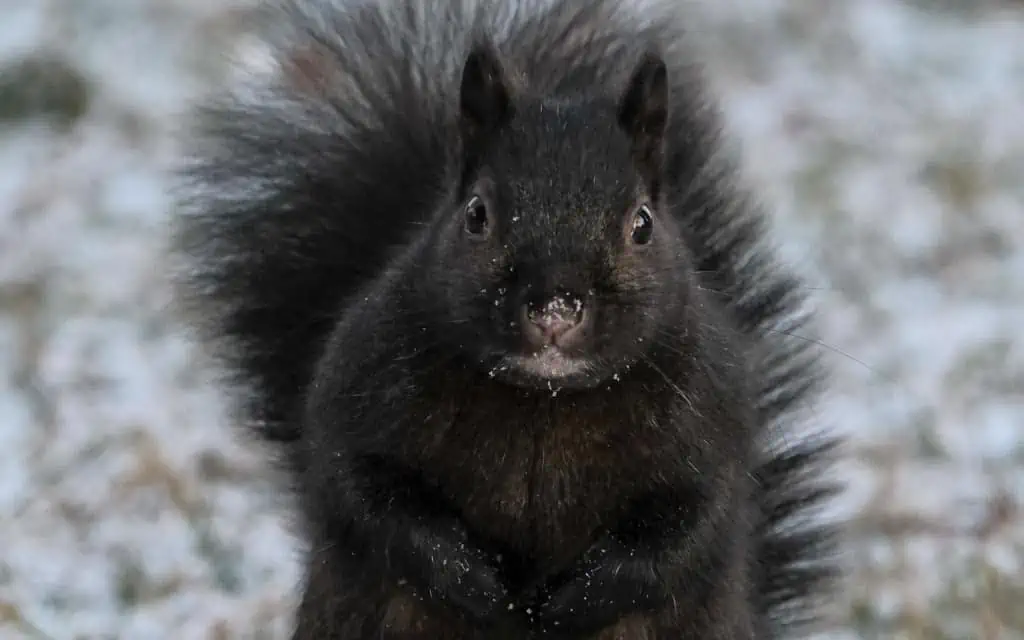
- Scientific Name: Various species of squirrels, including Sciurus carolinensis (the Eastern Gray Squirrel) and Sciurus niger (the Fox Squirrel)
- Habitat: They can be found in various habitats across North America, including urban areas, woodlands, and parks. They adapt well to different environments.
- Size: Black Squirrels are typically small to medium-sized rodents, with a body length of about 8 – 12″ (20 to 30 cm) and a bushy tail that can add an additional 6 – 10″ (15 to 25 cm) in length.
- Diet: They are herbivores, primarily feeding on a diet of nuts, seeds, fruits, and occasionally plant shoots or fungi.
Black Squirrels are a group of squirrels that exhibit melanism. This genetic condition results in excessive melanin production, the pigment responsible for their blackish appearance.
2. Bombay Cat

- Scientific Name: Felis catus
- Habitat: Domesticated feline companions, typically found in homes.
- Size: Medium-sized, weighing between 6 and 12 pounds (2.7 – 5.4 kg).
- Diet: High-quality commercial cat food.
The Bombay cat is a striking breed known for its sleek, all-black coat and captivating greenish-gold eyes. This breed was developed specifically to produce a black-furred cat. Despite their exotic appearance, they are of medium size, with a typical weight ranging from 6 to 11 pounds.
Originating in the United States, the Bombay cat’s diet mainly consists of high-quality cat food, and their shiny black coats require regular grooming to maintain their shiny appearance. This is one of the most beautiful black feline species.
3. Black Wolf
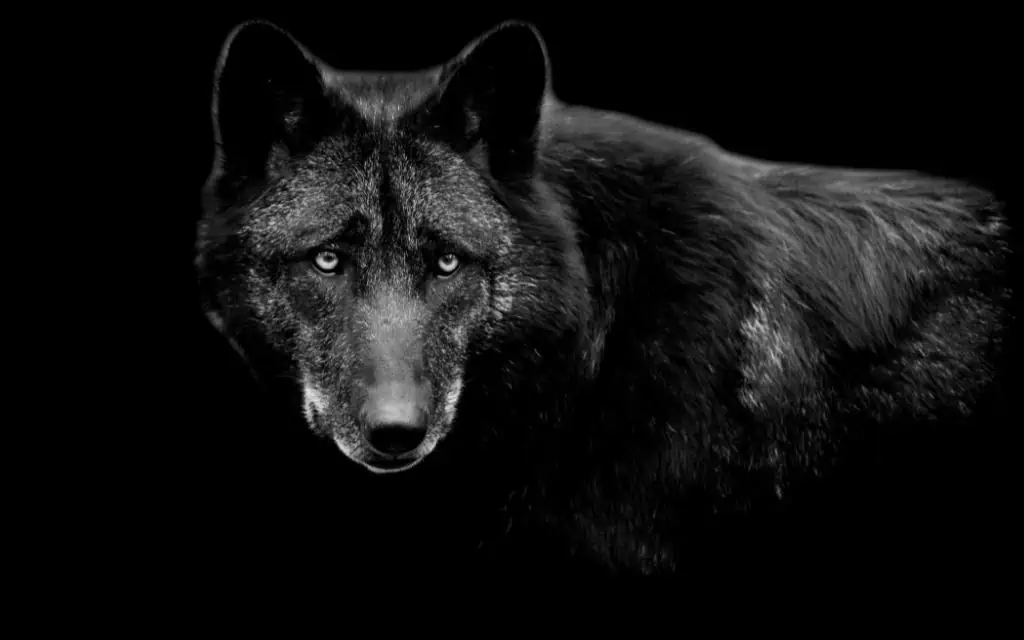
- Scientific Name: Canis lupus
- Habitat: Varied, including forests, tundras, and grasslands.
- Size: Shoulder height of 26 to 32 inches (66 to 81 cm), length of 4.5 to 6.5 feet (1.4 – 2 m).
- Diet: Carnivorous; primarily preys on ungulates such as deer, moose, and elk.
The black wolf, a remarkable variation of the gray wolf (Canis lupus), is distinguished by its predominantly black fur.
They are not a distinct species; rather, their color results from a genetic variation. They are found in North America, Europe, and Asia, where they share the same habitats and diets as their non-melanistic counterparts, primarily preying on ungulates like deer and moose.
Although black wolves are uncommon in most parts of the world, North America is home to many.
4. American Black Bear
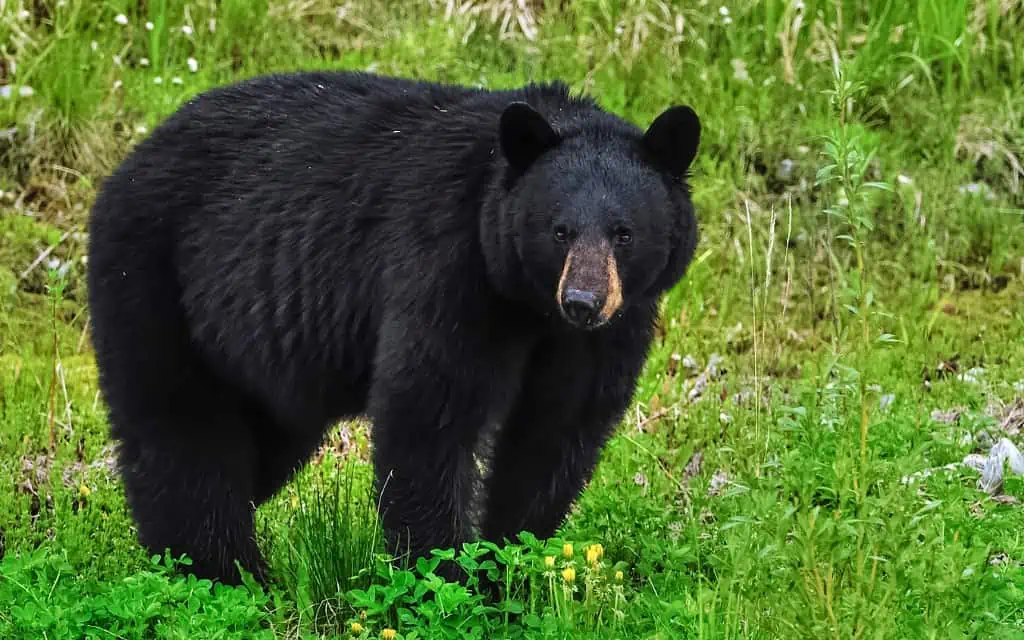
- Scientific Name: Ursus americanus
- Habitat: Various habitats across North America, including forests, swamps, mountains, and urban areas.
- Size: Typically 48 to 84 inches (4 to 7 feet) in length.
- Diet: Omnivorous; diet includes berries, nuts, plants, insects, small mammals, and occasionally larger prey like deer.
The American Black Bear (Ursus americanus) is a highly adaptable and widely distributed bear species native to North America. Despite the name, these bears can vary in color, from black to brown, cinnamon, or even white, although black is the most common.
While they are generally shy and solitary, they are strong and capable predators. They are omnivorous, with a diet that includes a variety of foods, making them opportunistic feeders. This diet flexibility allows them to adapt to changing seasons and food availability.
5. Black Panther
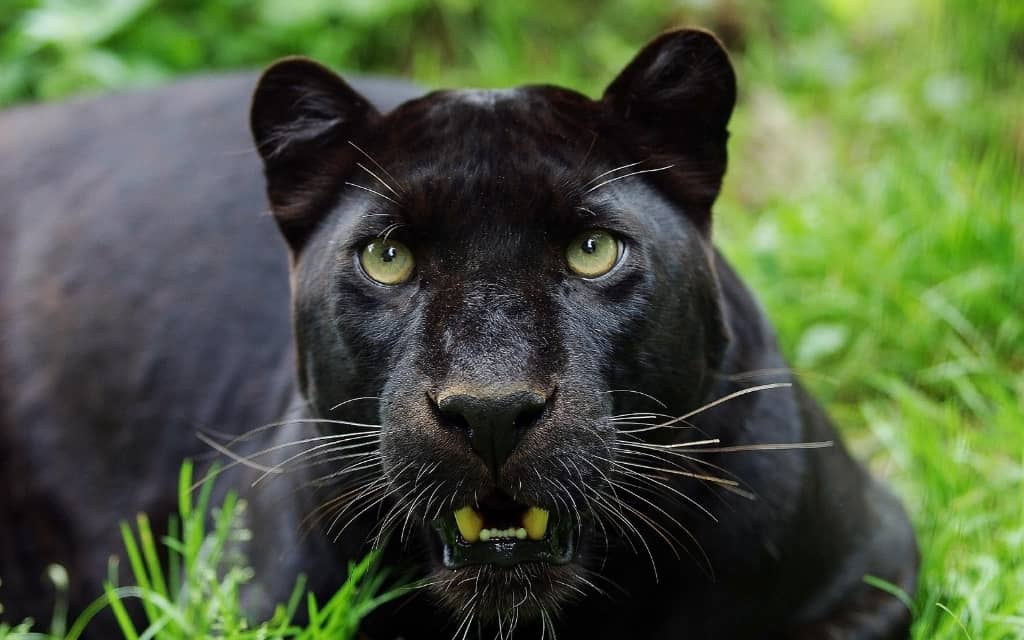
- Scientific Name: Panthera pardus (for the leopard) or Panthera onca (for the jaguar) – the melanistic variant
- Habitat: Various tropical forests across Southeast Asia, Africa (for the leopard), and the Americas (Central and South America for the jaguar).
- Size: around 36 to 74 inches in length (excluding the tail) and stand about 24 to 27 inches tall at the shoulder.
- Diet: Carnivorous; prey includes deer, wild boar, and smaller mammals.
Black panther is the melanistic variation of the popular jaguar or leopard. Also known as the black leopard or the black jaguar, they appear entirely black due to an excess of melanin pigment, masking their usual spotted patterns.
These mysterious creatures are known for their stealth and power, thriving in various habitats across Asia, Africa, and the Americas. Their adaptability and striking appearance have made them a symbol of strength and enigma in the animal kingdom.
6. Friesian Horse
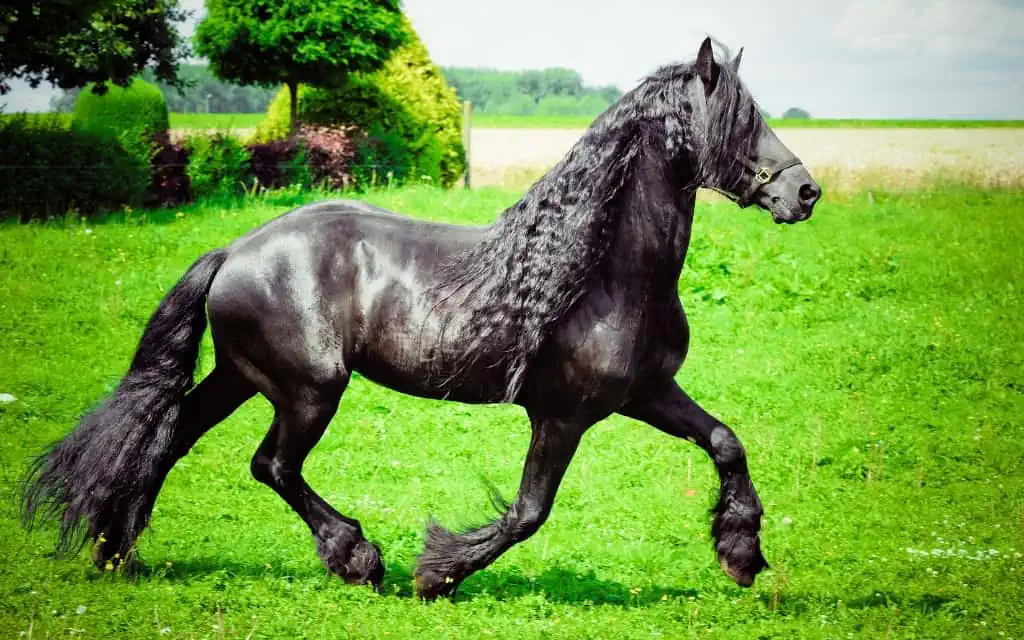
- Scientific name: Equus ferus caballus
- Habitat: Originally native to the Friesland region in the Netherlands, they are now bred and admired worldwide.
- Size: Average height of 15.3 hands (63 inches) tall at withers.
- Diet: Hay, grains, and fresh forage to maintain their robust physique.
The Friesian Horse, known for its majestic appearance, hails from the Friesland region in the Netherlands, where it has been cherished for centuries.
These horses are characterized by their striking black coats, flowing manes, and feathered lower legs, adding to their elegance. They are considered a medium-sized breed with an average height of 15.3 hands (63 inches).
Today, they are used in various equestrian disciplines, from dressage to driving. Moreover, this horse breed frequently appears in films due to its beautiful features.
7. Schipperke
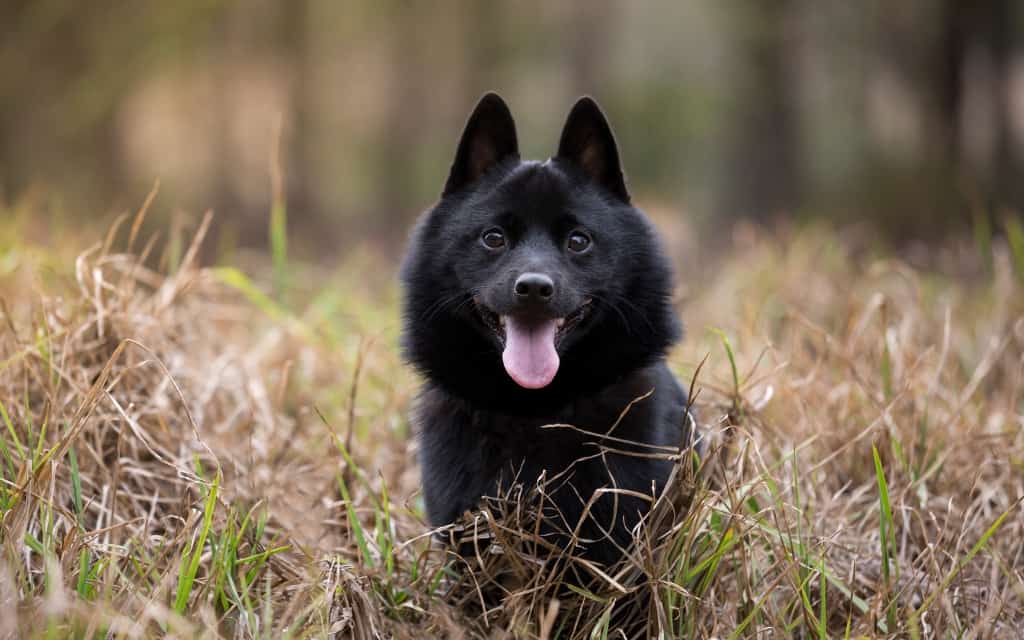
- Scientific Name: Canis lupus familiaris
- Habitat: Domesticated dogs that are typically kept as companions and pets. They adapt well to various living environments, including urban areas and homes with yards.
- Size: Small-sized dogs, with an average height of 10″ to 13″ (25 to 33 cm) at the shoulder and a weight ranging from 7 to 16 pounds (3 to 7 kg).
- Diet: Domestic dog food.
The Schipperke, a breed of domesticated dog, is known for its small size, distinctive appearance, and lively personality. Native to Belgium, this breed is also known as LBD, an acronym for little black devil.
They have a fox-like face, triangular ears, and a thick, double-black coat. Despite their small size, they are known for their bold and confident demeanor.
Moreover, they make loyal companions and often form strong bonds with their owners. They also love children.
It’s one of the most adorable all-black animals.
8. Black Angus
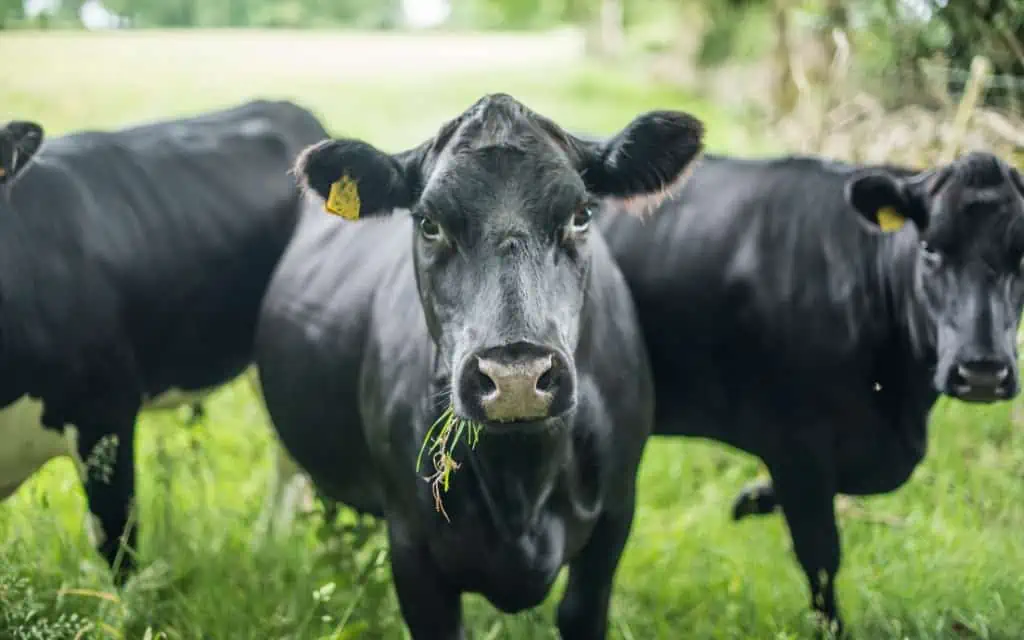
- Scientific Name: Bos taurus
- Habitat: They are a domesticated breed raised in various regions around the world, particularly in North America, Europe, and Australia.
- Size: Adult Angus typically weigh between 1,000 to 2,200 pounds (450 to 1,000 kilograms).
- Diet: They are herbivorous, primarily grazing on grass and forage.
The Black Angus is a popular beef breed species prized for its aromatic and succulent beef as it has thin and evenly distributed fat. Their reputation for producing high-quality beef has made them a favorite among ranchers and consumers alike.
Originating in Scotland, these cattle have become a prominent choice for beef production worldwide. They are also recognized for their adaptability to various climates.
9. Black Rat Snake
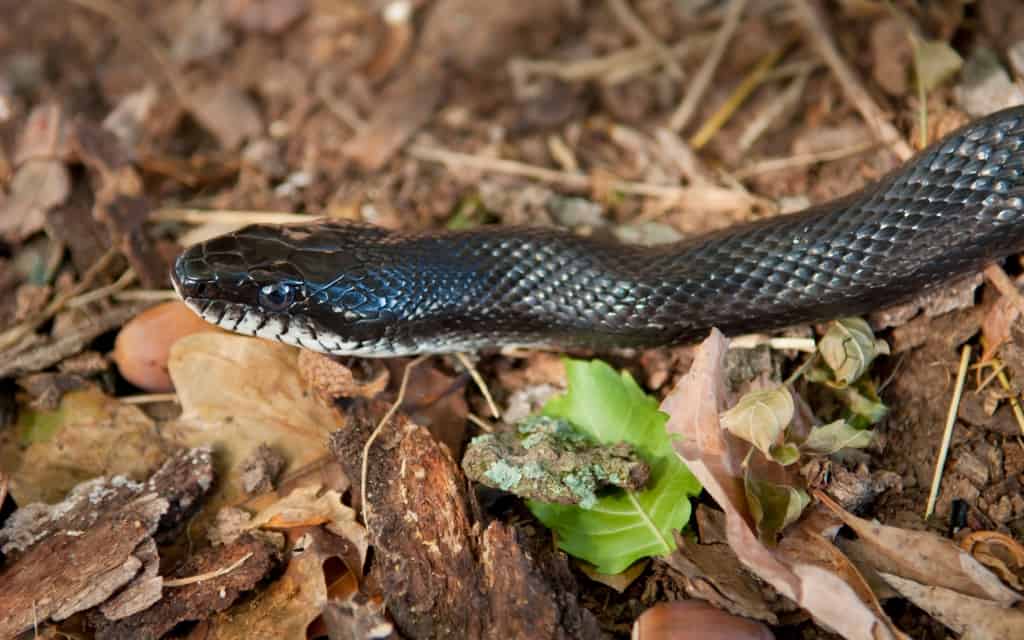
- Scientific Name: Pantherophis alleghaniensis
- Habitat: Can be found in many habitats, including forests, grasslands, farmlands, and even urban areas.
- Size: These snakes are among the larger snake species, with adults typically reaching lengths of 3 to 8 feet (91 cm to 2.4 m).
- Diet: They are constrictor snakes and feed on small amphibians such as frogs, lizards, and occasionally birds and eggs.
The Black Rat Snake, scientifically known as Pantherophis alleghaniensis, is a non-venomous snake native to North America. With a length of up to 8 feet, this is one of the longest snakes in North America.
These snakes are known for their striking appearance, featuring glossy black skin. However, they have some white or grayish scales on their undersides.
10. Black Tree Monitor
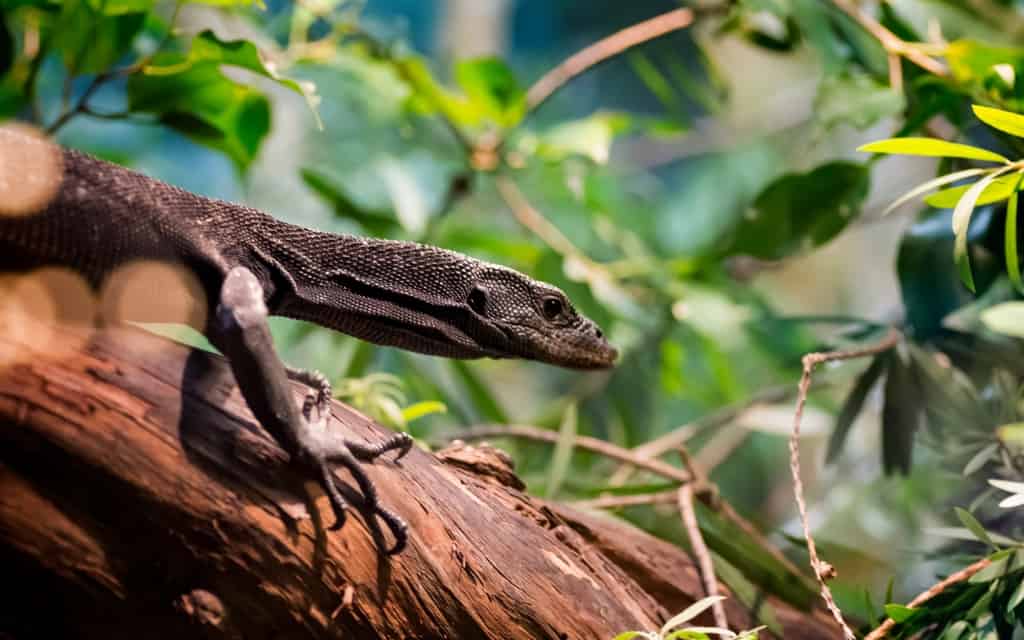
- Scientific Name: Varanus beccarii
- Habitat: They are primarily arboreal, spending most of their lives in New Guinea rainforest trees.
- Size: These monitors are relatively small compared to other monitor species, with adults typically reaching lengths of 36 to 42 inches (91 to 106 cm), including their long tails.
- Diet: Carnivorous, they feed on insects, small vertebrates, and bird eggs. They are skilled climbers, which helps them access prey in tree canopies.
The Black Tree Monitor is a fascinating and relatively small species of monitor lizard. Native to the lush rainforests of New Guinea and nearby islands, they are highly adapted to an arboreal lifestyle, spending much of their time in trees.
This reptile species is highly intelligent and can solve complex problems. In addition, the blackish scales on their bodies help them hide from predators.
11. Water Buffalo
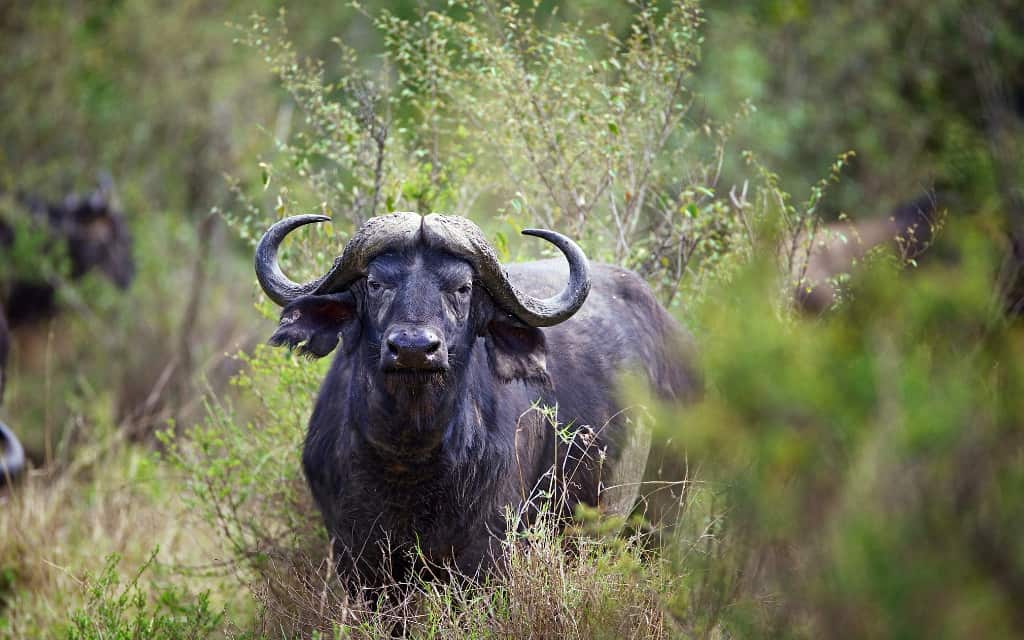
- Scientific Name: Bubalus bubalis
- Habitat: Domesticated and raised worldwide, particularly in wetlands and regions with access to water. Native to the Indian subcontinent, they can be found today in Southeast Asia, Africa, South America, and Europe (Italy and the Balkans).
- Size: Large (about 47″-52″ at the withers) and robust, with lengths of 6 to 9.8 feet and weights ranging from 1,100 to 2,200 pounds on average.
- Diet: Herbivores, grazing on grasses and aquatic plants.
The water buffalo is a domesticated bovine species known for its significant contributions to agriculture and farming in many parts of the world. It’s an essential work animal that plows fields, pulls carts, and provides milk. It’s also used for meat. For this reason, it is one of the most useful naturally black creatures for farmers.
Popular in Southeast Asia and South America, it has also been introduced in Europe – especially in the Balkans and Italy – and the Amazon basin.
12. King Cobra
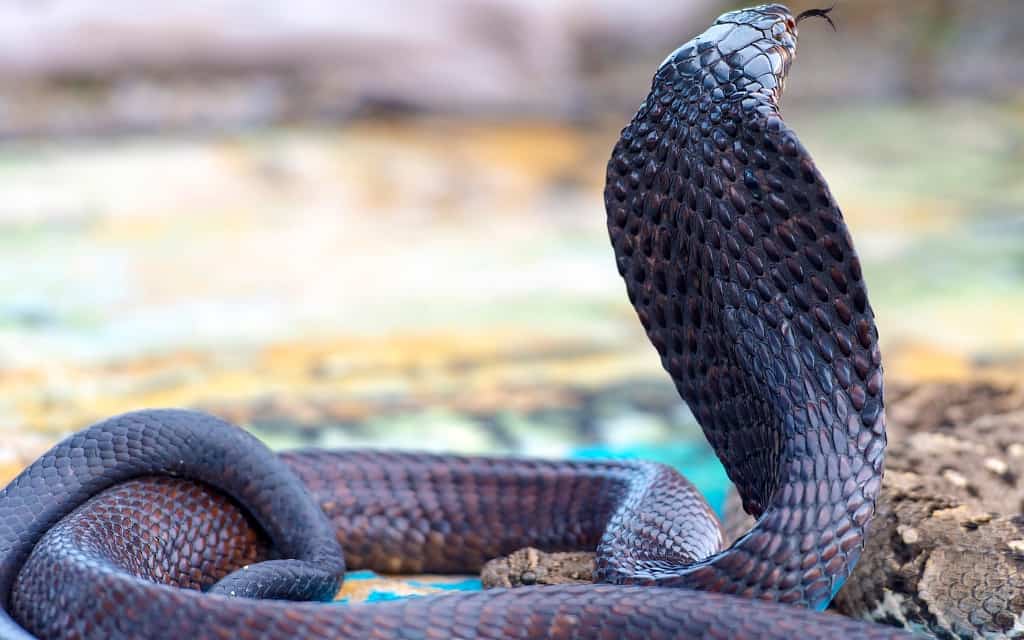
- Scientific Name: Ophiophagus hannah
- Habitat: They can be found in South and Southeast Asia, especially in forests, grasslands, and near water sources. They are also known to inhabit agricultural areas.
- Size: Adult individuals usually vary from 10 to 12 feet (3 – 3.6 meters) in length. Some specimens can reach up to 18 feet (5.4 meters).
- Diet: They are carnivorous and primarily feed on other snakes, including venomous species, lizards, and small mammals. Their diet contributes to their reputation as a “king.”
The king cobra is one of the most fearsome snake species on the planet, as well as the world’s longest venomous snake.
Native to Southeast Asia, these snakes are known for their impressive size, agility, and potent venom. They are appropriately named “king” due to their position as the largest venomous snake species in the world.
They inhabit a variety of environments, from dense forests and grasslands to agricultural areas, often seeking out water sources. In addition, they are highly skilled hunters, primarily preying on other snakes, including venomous ones, making them apex predators in their ecosystems.
13. Celebes Crested Macaque
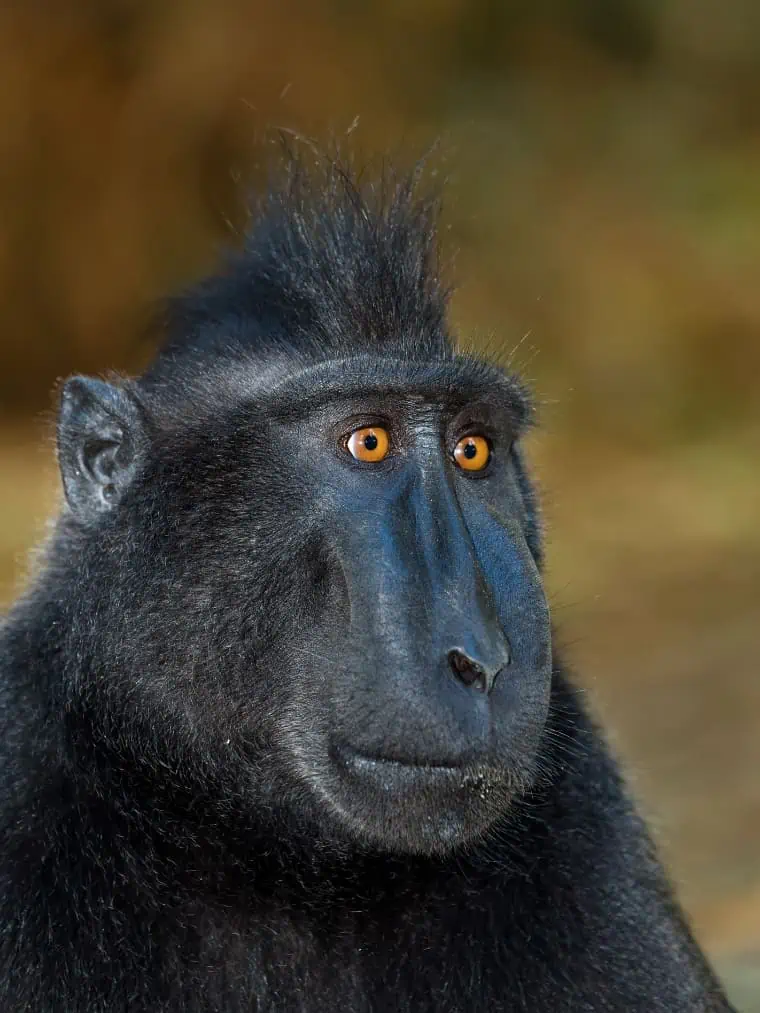
- Scientific Name: Macaca nigra
- Habitat: Native to the lush rainforests and coastal areas of Sulawesi, Indonesia.
- Size: Adult males typically measure between 1.71 and 1.87 ft (52 to 57 cm), while features range from 1.46 to 1.8 ft (44 to 47 cm). They weigh around 13 to 22 pounds (6 to 10 kilograms).
- Diet: Mostly frugivorous, they consume figs, fruits, and different fruit species of plant.
The Crested Black Macaque, also known as the black ape, is a captivating and critically endangered primate species native to the island of Sulawesi in Indonesia.
They are known for their expressive faces and distinctive black fur, which contrasts with their pink or pale face and buttocks.
14. Brandt’s Cormorant
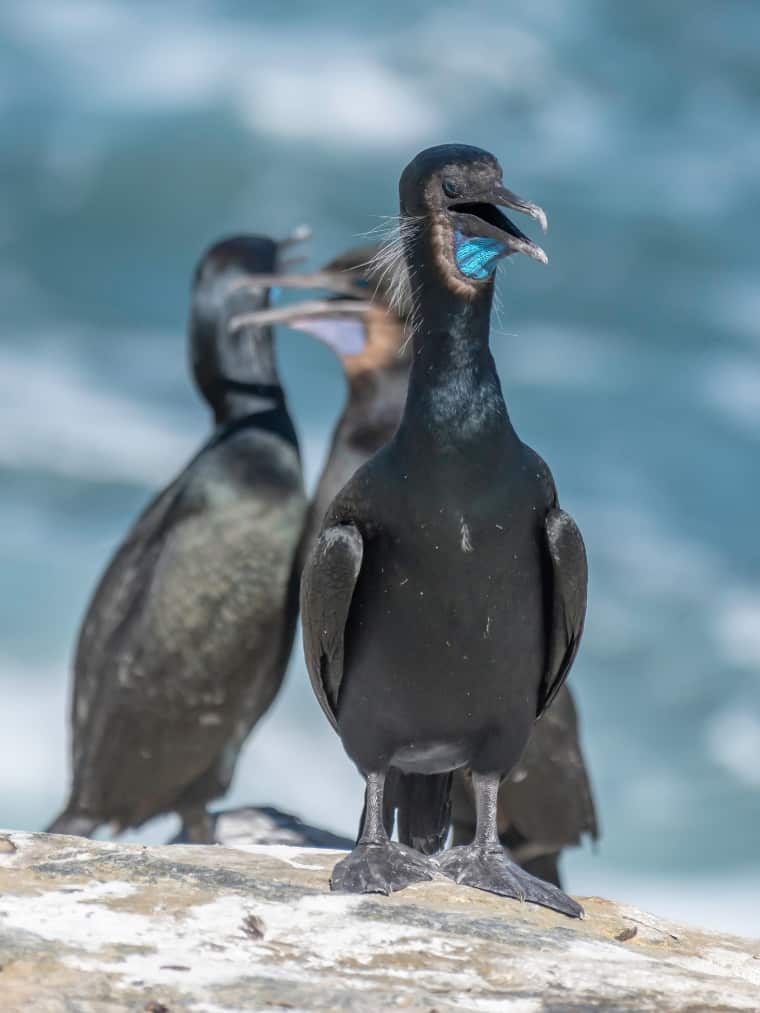
- Scientific Name: Urile penicillatus
- Habitat: They can be found along the Pacific Coast of North America, particularly in coastal areas from Alaska to Mexico. They prefer rocky shorelines, cliffs, and offshore islands for nesting and roosting.
- Size: Medium-sized birds, with a length of about 23 to 35 inches (58 to 89 centimeters) and a wingspan of around 38 to 40 inches (97 to 102 centimeters).
- Diet: Fish catch by diving underwater.
Brandt’s Cormorant is a coastal seabird species, or a marine bird, which is part of the cormorant seabird family. These cormorants are predominantly dark in color, with glossy black plumage and distinctive white patches on their flanks and thighs during the breeding season. Outside of the breeding season, their plumage becomes less distinct.
They are often seen perched on rocks or cliffs near the ocean, where they nest and roost.
However, they are highly adapted to their marine environment, with webbed feet and excellent underwater vision. These skilled swimmers can pursue their prey at depths of up to 40 feet.
15. Asian Black Bear
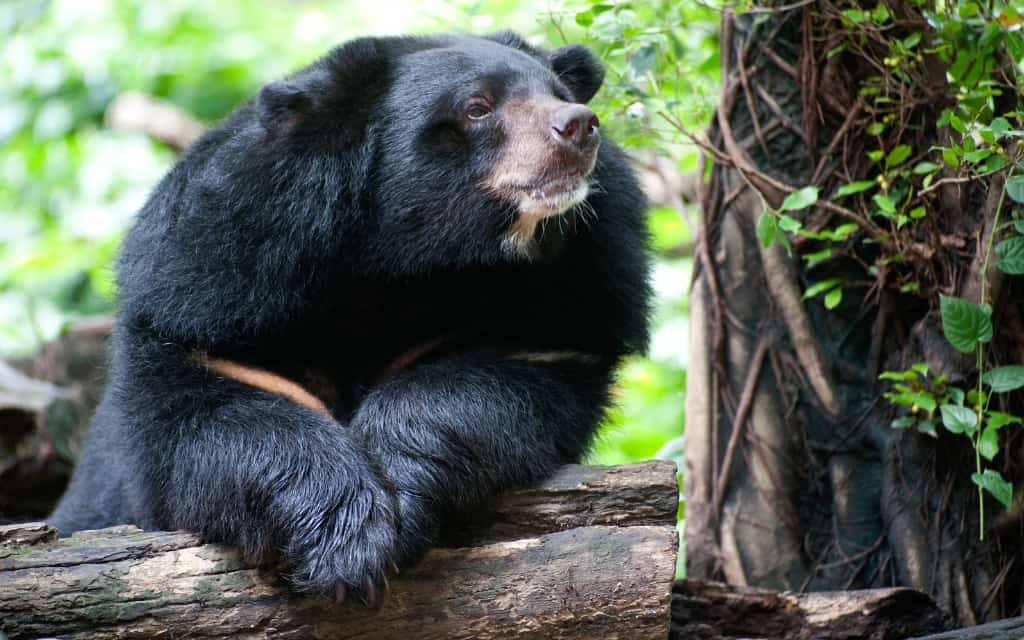
- Scientific Name: Ursus thibetanus
- Habitat: They can be found from southern Iran to the Himalayan region, Southeast Asia, and some parts of eastern Asia (Japan). They spend the summer in forested hills and mountains, reaching 11,800 feet (3,600 m).
- Size: Adults vary in size, with males typically weighing between 220 to 440 pounds (100 to 200 kilograms) and females being smaller, weighing around 110 – 275 pounds (50 to 125 kg). They have a body length of about 4.5 to 5.4 feet (1.4 to 1.6 meters).
- Diet: These bears are omnivorous and have a varied diet that includes fruits, berries, nuts, insects, small mammals, and occasionally larger prey such as deer.
Asian black bear, also known as the Himalayan bear, is native to Asia, with a black or sometimes brownish coat and a white crescent moon-shaped mark on its chest.
While they are generally shy and cautious, they can be more aggressive than the brown bears or the American black bears. They are skilled climbers and can run up to 50 km per hour.
Despite its name, these bears can range from blackish to brownish in color. Their shaggy fur and V-shaped white chest patch are distinctive features.
Although diurnal, they become nocturnal around human habitats.
16. Ayam Cemani Chicken
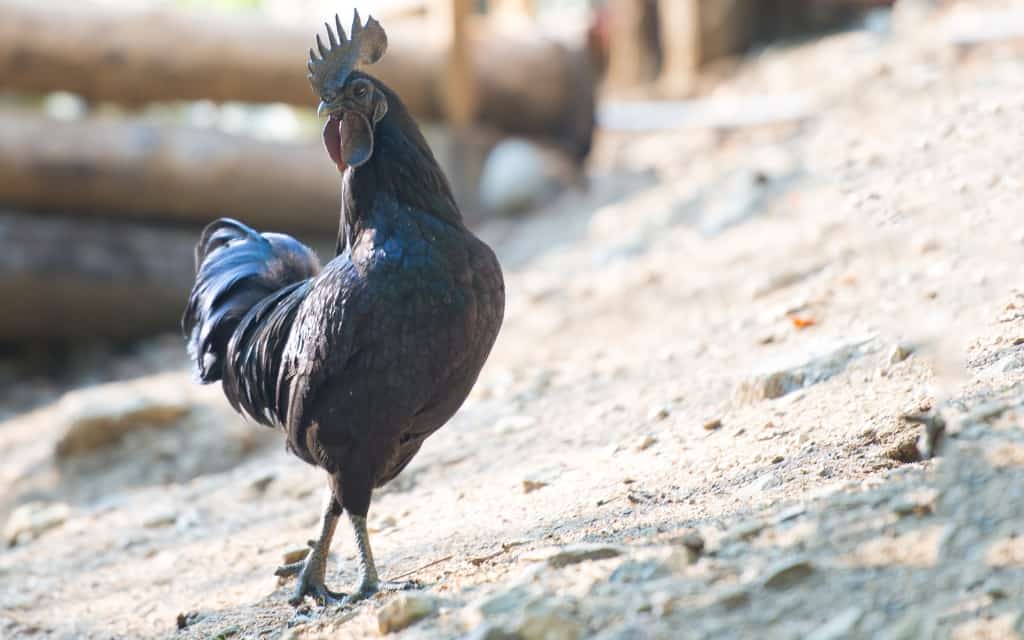
- Scientific Name: Gallus gallus domesticus
- Habitat: Native to Indonesia, they are typically raised by poultry enthusiasts and farmers.
- Size: These chickens are of medium size, with adult males weighing around 6 to 7 pounds (2.7 to 3.2 kg) and adult females weighing slightly less.
- Diet: A balanced diet of grains, seeds, vegetables, and insects.
The Ayam Cemani Chicken, native to Indonesia’s Java island, is a striking breed known for its entirely black plumage, skin, and even bones.
Despite their dark appearance, these chickens are friendly and docile birds, often sought after by poultry enthusiasts. Furthermore, they are good egg layers despite laying fewer eggs than other chicken breeds.
17. Sulawesi Black Sailfin Lizard
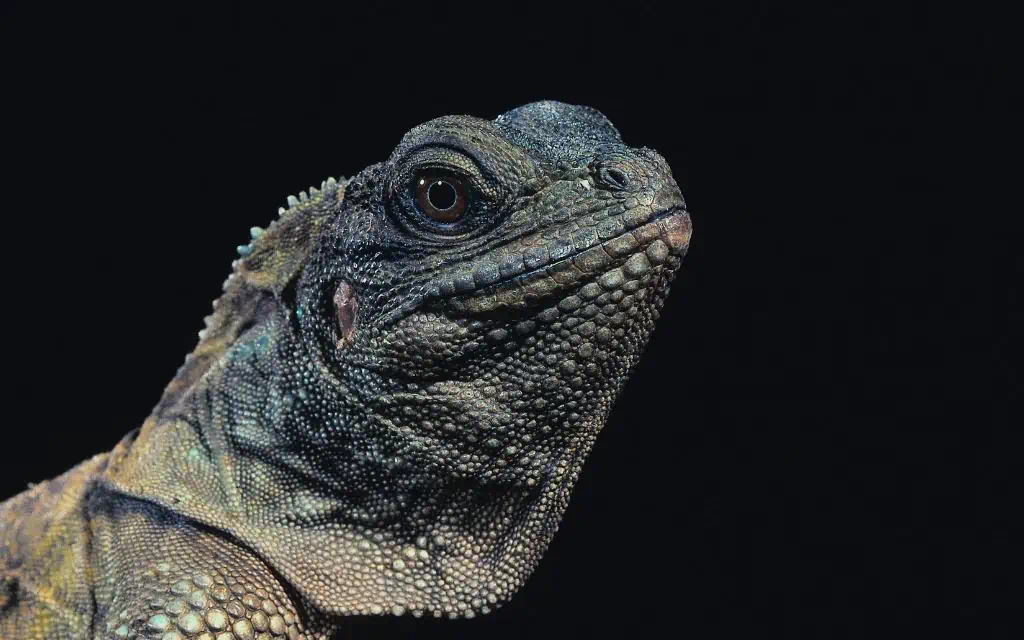
- Scientific Name: Hydrosaurus celebensis
- Habitat: They are native to the Indonesian island of Sulawesi, where they inhabit lush rainforests and forested areas near bodies of water, such as rivers and streams.
- Size: These lizards are relatively large, with adult males reaching lengths of about 3.3 to 3.9 feet (99 to 119 cm), including their sail-like dorsal fin. Females are slightly smaller.
- Diet: They are primarily herbivorous, feeding on leaves, fruits, flowers, and aquatic plants. Occasionally, they may consume small invertebrates.
The Sulawesi Black Sailfin Lizard is a giant black reptile species native to the Indonesian island of Sulawesi.
These lizards are renowned for their striking appearance, particularly the adult males with an impressive dorsal fin, often called a “sail,” along their back.
Resembling old-timey dinosaurs in appearance, they can easily exceed 3.2 feet (100 cm) in length.
18. Black Swan
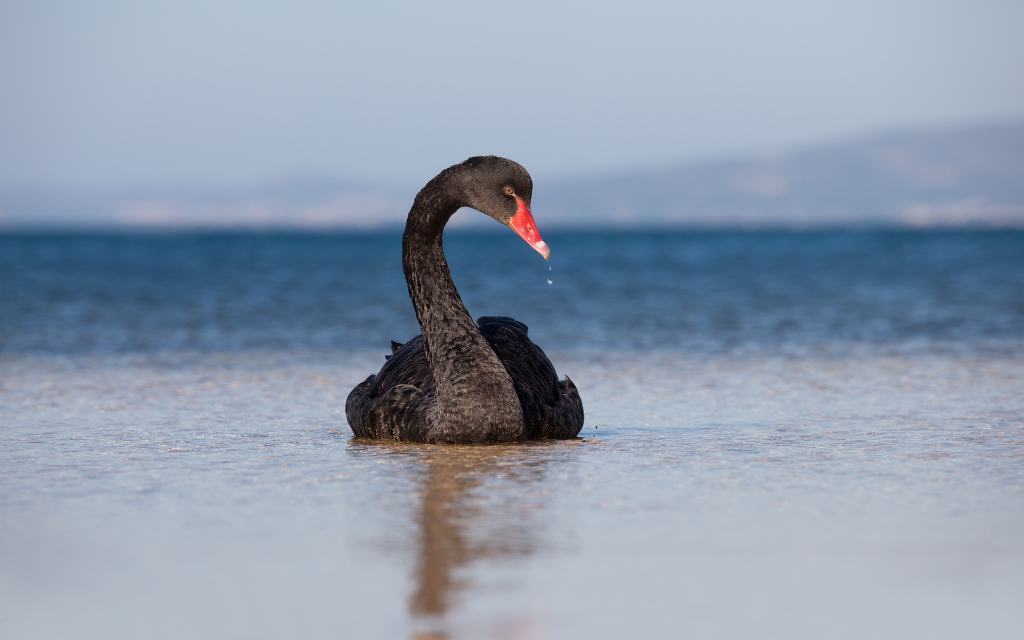
- Scientific Name: Cygnus atratus
- Habitat: Native to Australia, they can be found in the southeastern and southwestern parts of this country.
- Size: They are relatively large waterfowl, with an average length of 45 to 55 inches (115 to 140 cm) and a wingspan of approximately 5.6 to 6.6 feet (1.7 to 2 meters).
- Diet: These herbivores usually feed on aquatic plants, including submerged vegetation and algae, which they obtain by dipping their long necks underwater.
These birds are not entirely black but instead feature a black plumage with white wingtips. With a red beak, black plumage, whitish and brownish hues, these birds are a symbol of elegance and grace.
Despite being native to Australia, their distinct appearance has made them popular among ornamental bird enthusiasts.
19. Starry Night Cracker
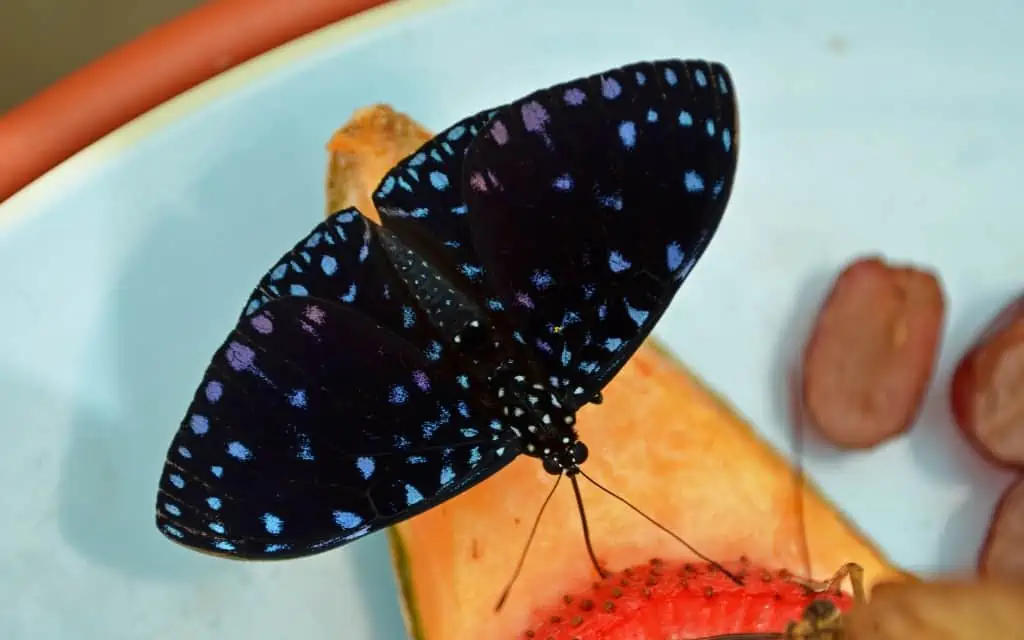
- Scientific Name: Hamadryas laodamia
- Habitat: They are typically found in tropical and subtropical regions of Central and South America and the Caribbean.
- Size: These butterflies have a wingspan of about 2.5 to 3 inches (6.4 to 7.6 cm), with distinctive and colorful wing patterns.
- Diet: The nectar of flowers and the rotting fruit juice.
The Starry Night Cracker is a visually captivating butterfly species known for its striking and intricate wing patterns. These patterns warn and keep predators away.
Interestingly, larval forms of these butterflies consume the toxic vine Dalechampia triphylla. Thus, these chemicals accumulate in the body, making these butterflies extremely distasteful to predators.
20. Black Saddlebag Skimmer
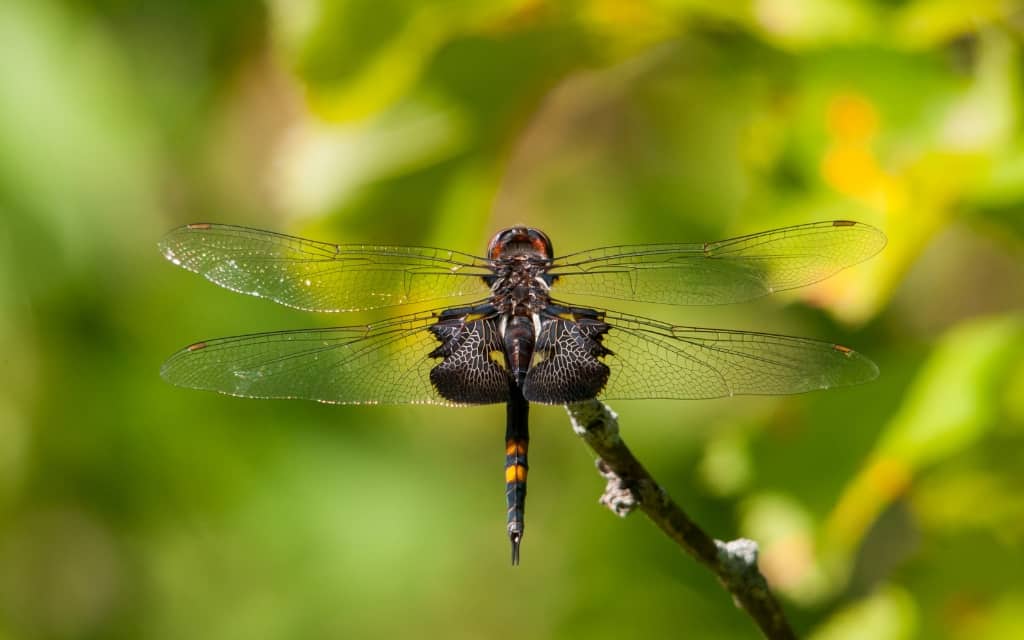
- Scientific Name: Tramea lacerata
- Habitat: These dragonflies can be found in North America, especially in the United States and southern Canada. They inhabit various aquatic habitats, including ponds, lakes, and slow-moving streams.
- Size: These dragonflies are medium-sized, with a wingspan ranging from 2.4″ to 2.8″ (6 to 7 cm).
- Diet: Small flying insects, such as flies and mosquitoes.
The Black Saddlebag Skimmer, also called Tramea lacerata, is a distinctive dragonfly species named for the dark patches at the base of its transparent wings, resembling saddlebags.
Their diet consists of small flying insects, making them beneficial for controlling mosquito populations in their habitats.
21. Phainopepla
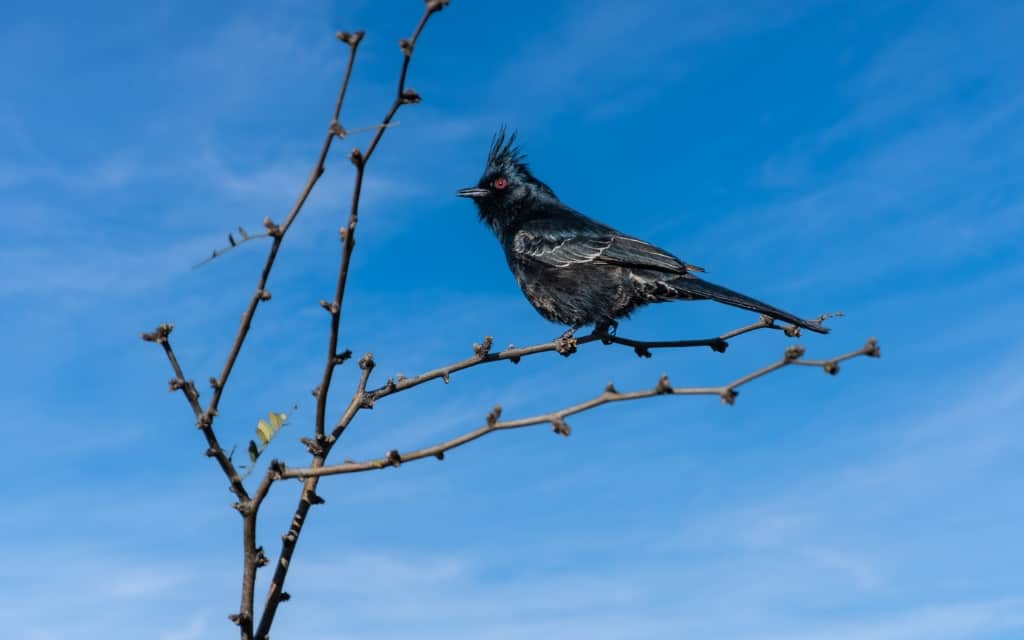
- Scientific Name: Phainopepla nitens
- Habitat: They are often found in arid and semi-arid regions, including deserts, scrublands, and woodlands.
- Size: These birds are small, with a length of approximately 7 to 8 inches (18 to 20 centimeters) and a wingspan of around 10 to 12 inches (25 to 30 centimeters).
- Diet: Fruits, mostly berries, insects, and vegetables.
Phainopepla is a small black bird native to the southwestern United States (California) and Mexico, with a distinctive black crest on its head.
These birds also feature glossy black plumage and bright crimson-red eyes.
Their diet consists of insects and berries, and they have a digestive tract specialized for eating mistletoe fruit. Thus, they can consume up to 1100 berries per day.
22. Common Raven
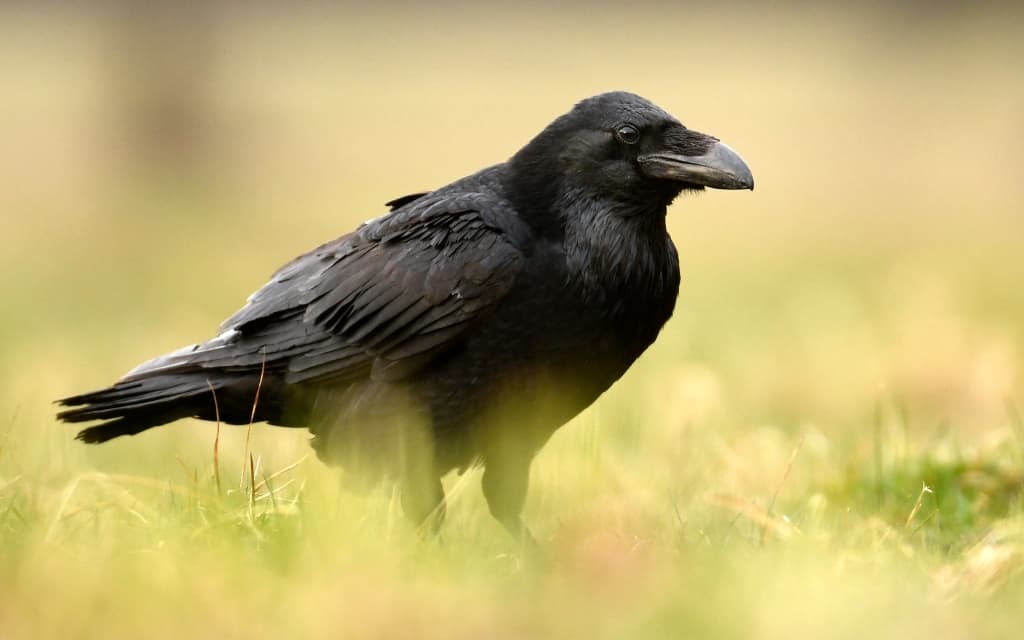
- Scientific Name: Corvus corax
- Habitat: They can be found in various habitats across North America, Europe, Asia, and North Africa.
- Size: These birds are relatively large, with a length of about 22″ to 27″ (56 to 69 cm) and a wingspan of 3.8 to 4.7 feet (115 to 143 cm).
- Diet: Carrion (dead animals), insects, eggs, fruits, and seeds.
The common raven is a highly intelligent and adaptable bird known for its glossy black plumage, strong beak, and distinctive croaking calls.
According to some studies, they are more intelligent than dogs or cats. Furthermore, their problem-solving ability is comparable to that of a 7-year-old.
Furthermore, they are the only non-primate species that communicates through gestures.
Final Thoughts on Black Animals Around the World
Black animals found in nature are not only visually stunning but also vital to the ecosystems they inhabit.
If you’re intrigued by the diversity of nature, take a moment to appreciate the elegance of these animals. The mystery of the back makes them even more interesting.
Frequently Asked Questions
Are black animals more endangered due to their distinctive appearance?
No, the color of an animal does not necessarily make it more endangered. Conservation status depends on various factors.
Do black animals have any evolutionary advantages?
Yes, in some cases, black animals may have an advantage in specific environments, such as absorbing heat in cold climates.
Are Melanistic animals black?
Yes, melanistic animals are black. They exhibit an excess of melanin, a pigment responsible for coloration, due to a genetic mutation. This overproduction of melanin leads to their strikingly dark or black appearance.
Are black swans truly black or just very dark gray?
Black swans have jet-black feathers, but they can appear slightly gray under certain lighting conditions.
How do black seahorses find their mates in the vast ocean?
Black seahorses use their distinctive colors and courtship dances to find compatible mates.
Why are crows often associated with superstitions and omens?
Crows’ intelligence and scavenging behavior have led to various cultural interpretations throughout history.

